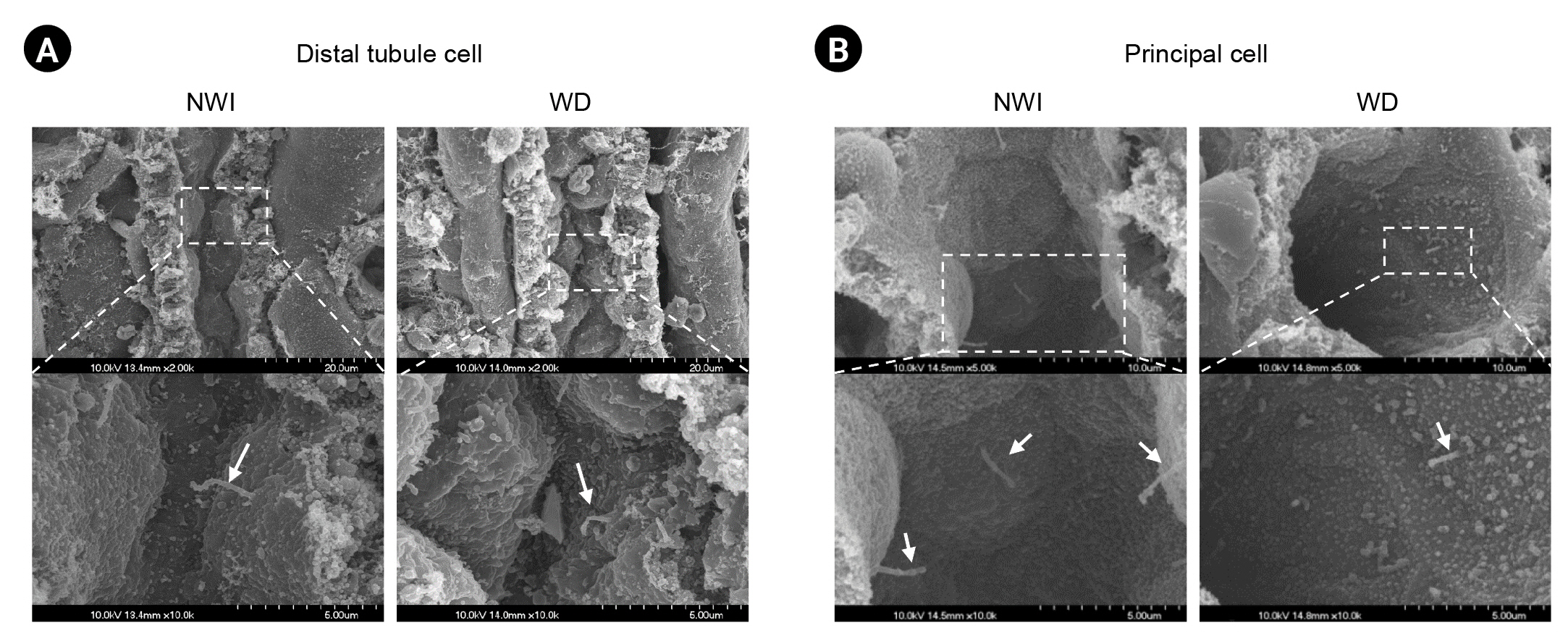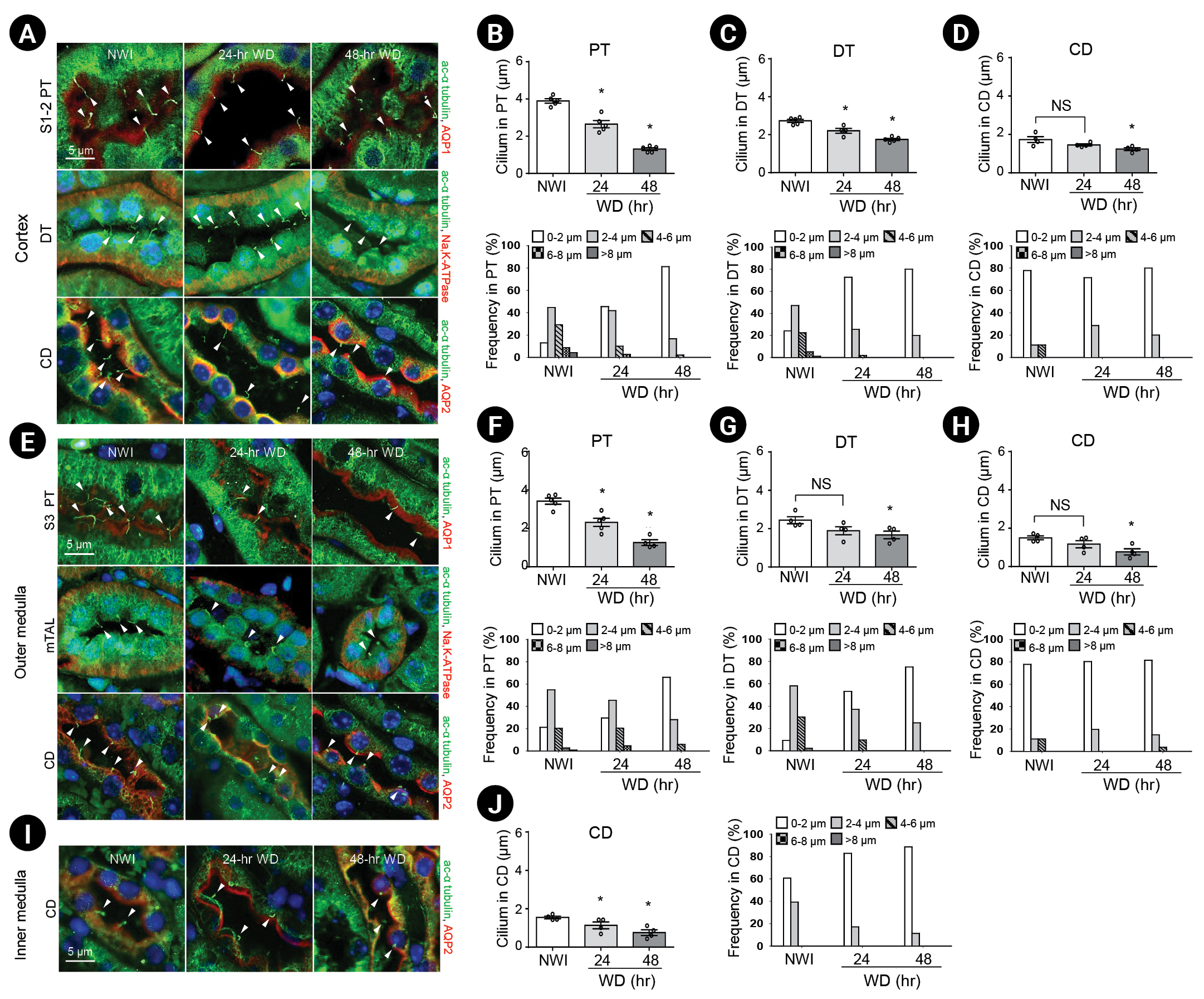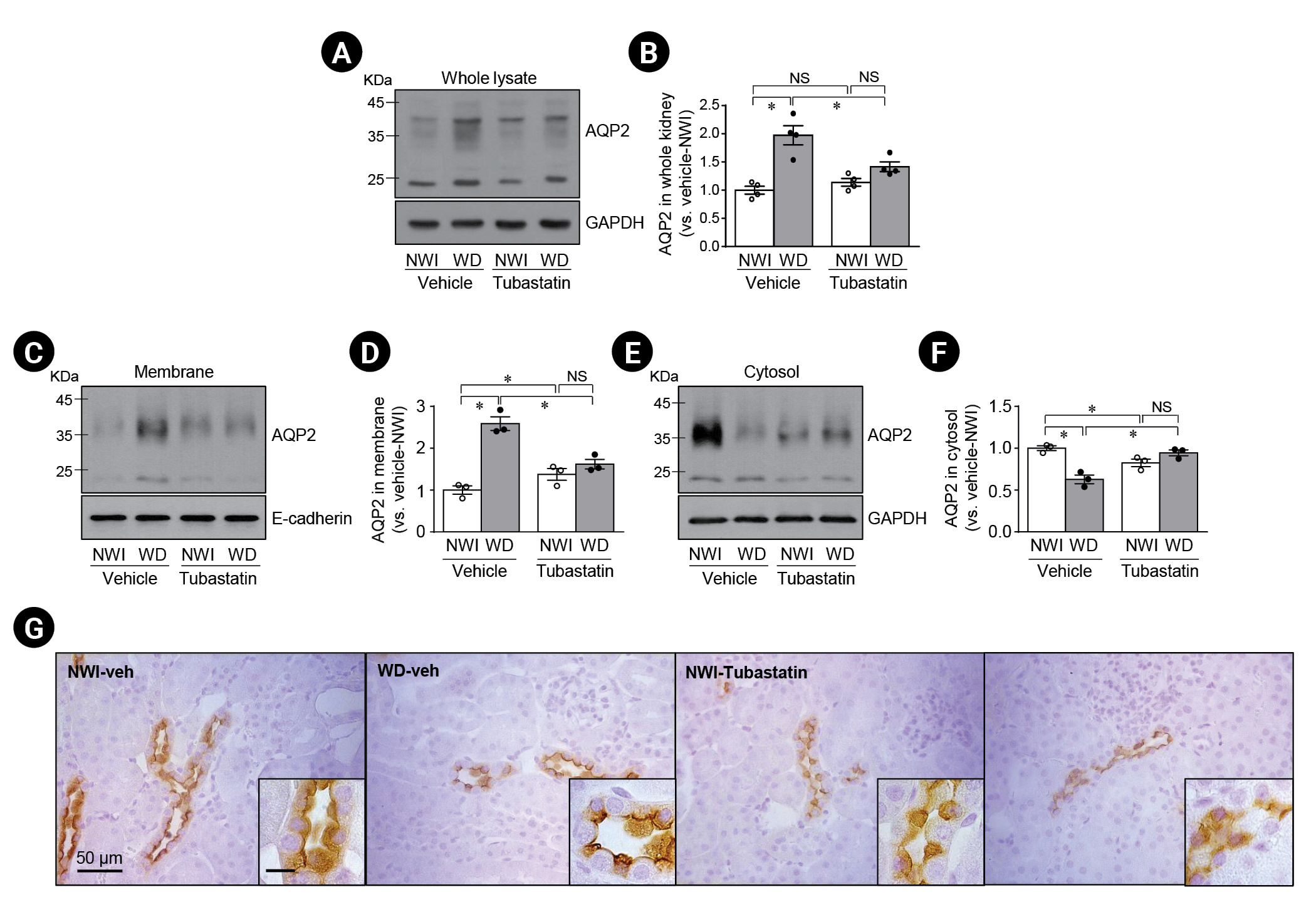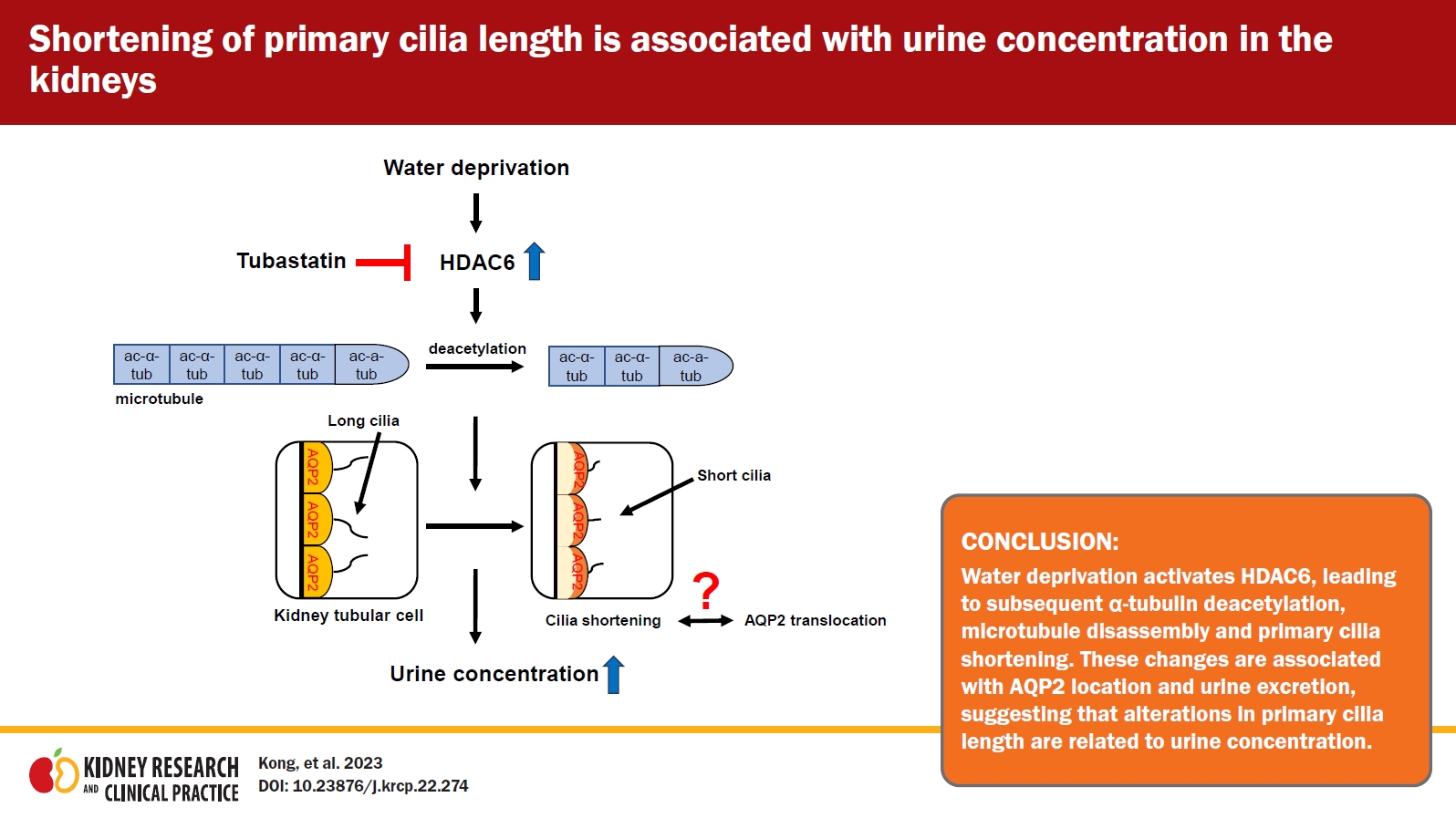1. Praetorius HA, Spring KR. Removal of the MDCK cell primary cilium abolishes flow sensing.
J Membr Biol 2003;191:69–76.



2. Avasthi P, Maser RL, Tran PV. Primary cilia in cystic kidney disease.
Results Probl Cell Differ 2017;60:281–321.



3. Davenport JR, Watts AJ, Roper VC, et al. Disruption of intraflagellar transport in adult mice leads to obesity and slow-onset cystic kidney disease.
Curr Biol 2007;17:1586–1594.



4. Gerdes JM, Christou-Savina S, Xiong Y, et al. Ciliary dysfunction impairs beta-cell insulin secretion and promotes development of type 2 diabetes in rodents.
Nat Commun 2014;5:5308.



6. Praetorius HA, Spring KR. A physiological view of the primary cilium.
Annu Rev Physiol 2005;67:515–529.


7. Praetorius HA, Spring KR. The renal cell primary cilium functions as a flow sensor.
Curr Opin Nephrol Hypertens 2003;12:517–520.


8. Wang L, Weidenfeld R, Verghese E, Ricardo SD, Deane JA. Alterations in renal cilium length during transient complete ureteral obstruction in the mouse.
J Anat 2008;213:79–85.



10. Kong MJ, Bak SH, Han KH, Kim JI, Park JW, Park KM. Fragmentation of kidney epithelial cell primary cilia occurs by cisplatin and these cilia fragments are excreted into the urine.
Redox Biol 2019;20:38–45.



11. Kim JI, Kim J, Jang HS, Noh MR, Lipschutz JH, Park KM. Reduction of oxidative stress during recovery accelerates normalization of primary cilia length that is altered after ischemic injury in murine kidneys.
Am J Physiol Renal Physiol 2013;304:F1283–F1294.


12. Han SJ, Jang HS, Seu SY, et al. Hepatic ischemia/reperfusion injury disrupts the homeostasis of kidney primary cilia via oxidative stress.
Biochim Biophys Acta Mol Basis Dis 2017;1863:1817–1828.


13. Verghese E, Ricardo SD, Weidenfeld R, et al. Renal primary cilia lengthen after acute tubular necrosis.
J Am Soc Nephrol 2009;20:2147–2153.



15. Haggarty SJ, Koeller KM, Wong JC, Grozinger CM, Schreiber SL. Domain-selective small-molecule inhibitor of histone deacetylase 6 (HDAC6)-mediated tubulin deacetylation.
Proc Natl Acad Sci U S A 2003;100:4389–4394.



16. Hubbert C, Guardiola A, Shao R, et al. HDAC6 is a microtubule-associated deacetylase.
Nature 2002;417:455–458.



17. Matsuyama A, Shimazu T, Sumida Y, et al. In vivo destabilization of dynamic microtubules by HDAC6-mediated deacetylation.
EMBO J 2002;21:6820–6831.



18. Smith Q, Macklin B, Chan XY, et al. Differential HDAC6 activity modulates ciliogenesis and subsequent mechanosensing of endothelial cells derived from pluripotent stem cells.
Cell Rep 2018;24:1930.


19. Vossenkämper A, Nedvetsky PI, Wiesner B, Furkert J, Rosenthal W, Klussmann E. Microtubules are needed for the perinuclear positioning of aquaporin-2 after its endocytic retrieval in renal principal cells.
Am J Physiol Cell Physiol 2007;293:C1129–C1138.


22. Choi SY, Ryu Y, Kee HJ, et al. Tubastatin A suppresses renal fibrosis via regulation of epigenetic histone modification and Smad3-dependent fibrotic genes.
Vascul Pharmacol 2015;72:130–140.


23. Park KM, Chen A, Bonventre JV. Prevention of kidney ischemia/reperfusion-induced functional injury and JNK, p38, and MAPK kinase activation by remote ischemic pretreatment.
J Biol Chem 2001;276:11870–11876.


25. Webber WA, Lee J. Fine structure of mammalian renal cilia.
Anat Rec 1975;182:339–343.


26. Kim S, Tsiokas L. Cilia and cell cycle re-entry: more than a coincidence.
Cell Cycle 2011;10:2683–2690.



27. Zhang Y, Li N, Caron C, et al. HDAC-6 interacts with and deacetylates tubulin and microtubules in vivo.
EMBO J 2003;22:1168–1179.



28. Brazzuna H, García Pierce H, Libermann IM. Blood changes in water deprived rats.
Acta Physiol Lat Am 1975;25:83–88.

29. de Fost M, Oussaada SM, Endert E, et al. The water deprivation test and a potential role for the arginine vasopressin precursor copeptin to differentiate diabetes insipidus from primary polydipsia.
Endocr Connect 2015;4:86–91.



30. Bekkevold CM, Robertson KL, Reinhard MK, Battles AH, Rowland NE. Dehydration parameters and standards for laboratory mice.
J Am Assoc Lab Anim Sci 2013;52:233–239.


31. Mashiach E, Sela S, Winaver J, Shasha SM, Kristal B. Renal ischemia-reperfusion injury: contribution of nitric oxide and renal blood flow.
Nephron 1998;80:458–467.



32. Nag S, Resnick A. Biophysics and biofluid dynamics of primary cilia: evidence for and against the flow-sensing function.
Am J Physiol Renal Physiol 2017;313:F706–F720.


33. Praetorius HA. The primary cilium as sensor of fluid flow: new building blocks to the model: a review in the theme: cell signaling: proteins, pathways and mechanisms.
Am J Physiol Cell Physiol 2015;308:C198–C208.


34. Gilmer GG, Deshpande VG, Chou CL, Knepper M. Flow resistance along the rat renal tubule.
Am J Physiol Renal Physiol 2018;315:F1398–F1405.



35. Siroky BJ, Kleene NK, Kleene SJ, et al. Primary cilia regulate the osmotic stress response of renal epithelial cells through TRPM3.
Am J Physiol Renal Physiol 2017;312:F791–F805.



38. Imai M. Urinary concentration and dilution mechanism of the kidney.
Nihon Rinsho 1980;38:2860–2870.

39. Rymut SM, Harker A, Corey DA, et al. Reduced microtubule acetylation in cystic fibrosis epithelial cells.
Am J Physiol Lung Cell Mol Physiol 2013;305:L419–L431.



















 PDF Links
PDF Links PubReader
PubReader ePub Link
ePub Link Full text via DOI
Full text via DOI Download Citation
Download Citation Print
Print















